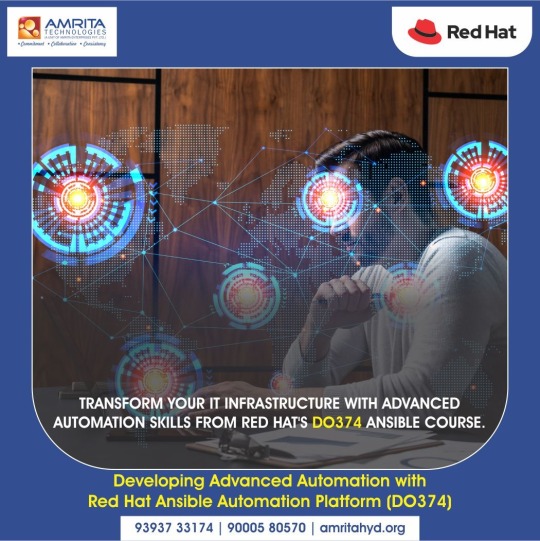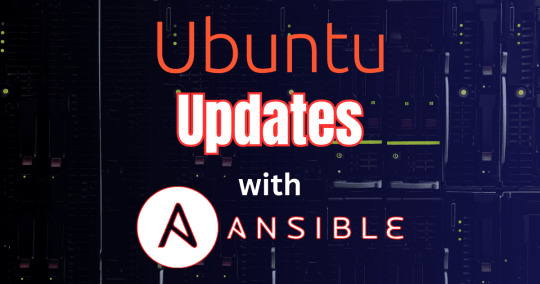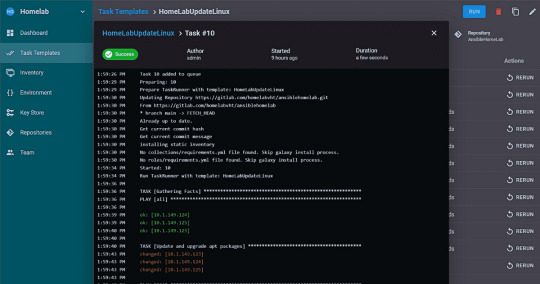#ansibleautomation
Text
Real-World Applications of RHCSA and RHCE Skills
The Red Hat Certified System Administrator (RHCSA) and Red Hat Certified Engineer (RHCE) certifications are highly regarded in the IT industry. These certifications validate an individual's skills in managing and automating Red Hat Enterprise Linux environments. However, the value of these certifications extends beyond just passing exams; the skills acquired are directly applicable to various real-world scenarios in the IT domain. Let's explore some of the practical applications of RHCSA and RHCE skills.
1. Server Management and Maintenance
RHCSA:
User and Group Management: Creating, modifying, and managing user accounts and groups. This is crucial for maintaining security and organization within a server environment.
File Permissions and ACLs: Setting appropriate permissions and access control lists to protect sensitive data and ensure users have the necessary access to perform their jobs.
Service Management: Starting, stopping, enabling, and disabling services using systemctl. This is essential for maintaining the uptime and performance of services.
RHCE:
Advanced System Monitoring: Using tools like top, htop, vmstat, and iotop to monitor system performance and diagnose issues.
Network Management: Configuring and troubleshooting network interfaces, firewalls, and SELinux settings to secure and optimize network communications.
2. Automating System Administration Tasks
RHCSA:
Shell Scripting: Writing basic scripts to automate repetitive tasks, such as backups, user creation, and log rotation.
Cron Jobs: Scheduling routine tasks to run automatically at specified times, ensuring consistent system maintenance without manual intervention.
RHCE:
Ansible Automation: Utilizing Ansible for configuration management and automation. Creating playbooks to automate complex multi-tier deployments and configurations.
Automating Deployments: Streamlining the process of deploying applications and services using automated scripts and configuration management tools.
3. System Security and Compliance
RHCSA:
Security Enhancements: Implementing basic security measures such as configuring firewalls with firewalld, and managing SELinux to enforce security policies.
Auditing and Logging: Setting up and maintaining system logs to monitor and audit system activities for compliance and troubleshooting purposes.
RHCE:
Advanced Security Configurations: Applying more sophisticated security measures such as configuring advanced SELinux policies, managing TLS/SSL certificates for secure communications, and implementing secure SSH practices.
System Auditing and Reporting: Using tools like auditd to create detailed security audits and reports, ensuring systems comply with security policies and standards.
4. Troubleshooting and Problem Solving
RHCSA:
Basic Troubleshooting: Using commands like journalctl, dmesg, and systemctl to diagnose and resolve common issues related to system performance, boot processes, and service failures.
Disk Management: Managing storage with LVM (Logical Volume Management) and understanding disk usage with tools like df and du.
RHCE:
Advanced Troubleshooting: Diagnosing complex issues involving network services, storage systems, and application performance. Using advanced tools and techniques to pinpoint and resolve problems.
System Recovery: Implementing disaster recovery plans, including restoring from backups, repairing boot issues, and recovering corrupted file systems.
5. Managing Enterprise Environments
RHCSA:
Package Management: Installing, updating, and managing software packages using yum or dnf, ensuring that systems have the necessary software and updates.
Network Configuration: Setting up and managing basic network configurations, including IP addresses, DNS settings, and hostname configurations.
RHCE:
Centralized Authentication: Setting up and managing centralized authentication services such as LDAP, Kerberos, and integrating with Active Directory.
Clustering and High Availability: Configuring and managing Red Hat High Availability Clustering to ensure critical services are always available.
6. DevOps and Continuous Integration/Continuous Deployment (CI/CD)
RHCSA:
Version Control Systems: Basic knowledge of version control systems like Git, which is fundamental for managing code and configuration files.
Containerization: Introduction to containerization concepts using tools like Docker.
RHCE:
CI/CD Pipelines: Setting up and managing CI/CD pipelines using tools like Jenkins, GitLab CI, or Red Hat OpenShift, enabling automated testing, integration, and deployment of applications.
Advanced Container Management: Managing and orchestrating containers using Kubernetes and Red Hat OpenShift, ensuring scalable and reliable deployment of containerized applications.
Conclusion
The skills acquired through RHCSA and RHCE certifications are not just theoretical but have direct, practical applications in the real world. Whether it's managing and securing servers, automating administrative tasks, or setting up robust enterprise environments, these certifications equip IT professionals with the knowledge and tools necessary to excel in their careers. By applying these skills, professionals can ensure efficient, secure, and high-performing IT operations, ultimately driving organizational success.
For more details click www.qcsdclabs.com
#redhatcourses#information technology#containerorchestration#kubernetes#docker#linux#container#qcsdclabs#rhcsa#rhce#devops#ansibleautomation
0 notes
Text

Register here to join him: https://lnkd.in/dumUxaf5
Shubham Katara is going to share some extra thoughts and insights on Kubernetes!☸️
Don't miss his masterclass. It's not only about learning! it's about developing your career path!✨
Register now!! it's on 12th November at 10 AM🕙
#kubernetescluster#kubernetessecurity#kubernetesmanagement#ansible#ansibleautomates#ansiblefest#automation#automationsolutions#clusters#containers#containerization#mumbaijobs#hyderabadjobs#bengalurujobs#job#beginners#freshers#technical#technologysolutions
0 notes
Text

Revolutionize Your IT Infrastructure: Master Advanced Automation with Red Hat's DO374 Ansible Course
#AmritaTechnologies #amrita #do374course #do374 #AnsibleAutomation #RHLS #rhls #redhatlearningsubcriptions #RHCSA #redhatsystemadministration #rhcsa #LinuxMastery #RH294 #LinuxAutomation #linuxautomationansible #do374course #OpenSourceJourney #DO374Empowers #MasterTheFuture #RHCSA #rhcsa #redhatsystemadministrator #redhatsystemadministration
0 notes
Text
How to Update Ubuntu with Ansible
How to Update Ubuntu with Ansible #vmwarecommunities #vexpert #devops #ansible #ansibleautomation #automatedupdates #updateubuntu #ubuntuupdates #virtualizationhowto #vhtforums #homelab #homeserver #configurationmanagement #infrastructureascode
One of the best ways to handle updating your Linux boxes is using automation. Using some type of automation for updates is a great way to make sure these get applied in a consistent way and regularly. If you are running multiple Ubuntu servers, automating updates with Ansible is a great way to install the latest version of updates on your remote server environments and update packages installed.…

View On WordPress
0 notes
Link
0 notes
Photo

New Mug! And some stickers for the office. Ansible Automates! #devops #cloud #redhat #linux #ansible #dev #bogota #colombia #developer #developers #development #developerlife #devopsdays #ansibleautomates (at Hall 74 Centro de Eventos) https://www.instagram.com/p/Bzs5tnFnJte/?igshid=47lx7qn4hqbg
#devops#cloud#redhat#linux#ansible#dev#bogota#colombia#developer#developers#development#developerlife#devopsdays#ansibleautomates
1 note
·
View note
Photo

Amsterdam, you were amazing. Even though it was a short little visit, it was the best. The event was great, the people were great, the food was great. Until next time my friends! #ansibleautomates (at Amsterdam Centraal)
0 notes
Photo

Amrita Technologies is one in all best RedHat AnsibleAutomation DO407 Training in Hyderabad employment institutions in Republic of Republic of India that provides courses in Network Solutions to students. we provide comprehensive employment in high end certification programs like Redhat Linux system, Ansible,DevOps ,OpenShift etc. Our quality standards ar terribly high which we have a tendency to use proven technology processes that ar credible and last at constant time for additional www.amritahyd.org
0 notes
Text
RT @akira6592: Day2 で、ネットワーク自動化のお話をさせていただきます。よろしくおねがいします。 https://t.co/CwRIjCiHTH #ansibleautomates
Day2 で、ネットワーク自動化のお話をさせていただきます。よろしくおねがいします。https://t.co/CwRIjCiHTH#ansibleautomates
— よこち(yokochi) (@akira6592) June 16, 2020
via Twitter https://twitter.com/suwa_sh
June 17, 2020 at 03:05AM
0 notes
Link
0 notes
Link
अगर आप मकान खरीदने की योजना बना रहे हैं तो प्रधानमंत्री आवास योजना आपका काम आसान कर सकती है.
#प्रधानमंत्रीआवासयोजना
#JanAwasYojna
#AnsibleAutomates
@9210333666
http://www.migsun-janawasyojana.in/
0 notes
Text
Unleashing the Power of Automation with Red Hat Ansible: A Game-Changer for IT Operations
In today's dynamic digital landscape, where agility and efficiency are paramount, the role of automation in IT operations cannot be overstated. Red Hat Ansible emerges as a transformative force, revolutionizing traditional IT management paradigms and ushering in an era of unprecedented efficiency and innovation.
In this article, we delve into the profound impact of Red Hat Ansible on IT operations, illuminating its role as a game-changer in modern infrastructure management. From simplifying complex workflows to accelerating delivery cycles, Ansible's simplicity and versatility empower organizations to navigate the complexities of modern IT environments with ease.
Our exploration extends beyond the technical capabilities of Ansible to its broader implications for organizational agility and competitiveness. We showcase real-world success stories of enterprises leveraging Ansible to drive digital transformation, enhance operational efficiency, and stay ahead of the curve in an increasingly competitive market landscape.
Furthermore, we delve into the security and compliance aspects of Ansible, highlighting its robust security features and built-in governance mechanisms that ensure automation initiatives remain steadfastly aligned with organizational security protocols.
Through this article, we aim to offer readers practical insights, expert guidance, and best practices for harnessing the full potential of Red Hat Ansible. Our goal is to empower IT professionals and decision-makers with the knowledge and tools they need to embark on their automation journey confidently.
We believe that "Unleashing the Power of Automation with Red Hat Ansible" aligns with the interests and focus areas of your publication's audience, and we are confident that it will resonate with your readers.
For more details click www.qcsdclabs.com
#linux#redhatcourses#information technology#kubernetes#ansible#ansibleautomation#container#dockerswarm#docker#aws#containerorchestration#containersecurity
0 notes
Text

Register here to join him: https://lnkd.in/dumUxaf5
Kubernetes Captain: Hands-On Lessons From our Docker Captain!
Register now if not registered yet!!
Captain Shubham is all set to share some extra insight with you!!
Register now!! it's on 12th November at 10 AM
#kubernetescluster#kubernetessecurity#kubernetesmanagement#ansible#ansibleautomates#ansiblefest#automation#automationsolutions#clusters#containers#containerization#mumbaijobs#hyderabadjobs#bengalurujobs#job#beginners#freshers#technical#technologysolutions
0 notes
Text

Enhance Your Efficiency with Red Hat and Ansible – Enroll in RH294 Now!"
Boost your productivity and streamline operations by joining RH294 to harness the power of Red Hat and Ansible.
Visit: https://amritahyd.org/
Click here: https://skills.ole.redhat.com/en?partner=learning_amrita
Enroll Now- 90005 80570
#AmritaTechnologies #amrita#RH294 #AnsibleAutomation #RH294 #rh403 #redhatsatillite6 #cka #rhls
0 notes
Text
Ansible Semaphore: Awesome Open Source Ansible GUI
Ansible Semaphore: Awesome Open Source Ansible GUI @vexpert #100daysofhomelab
#AnsibleAutomation #AnsibleGUI #AnsibleSemaphoreSetup #JobTemplatesInSemaphore #AnsibleInventoryManagement #AnsibleSemaphoreConfiguration #OpenSourceAnsibleAlternatives
Ansible is an awesome automation tool that I use in the home lab and production environment regularly. However, sometimes it is nice to have a GUI to point and click around to configure jobs, inventory, etc. Ansible has a commercial product called Ansible Tower and also an open-source product AWX that you can stand up. However, these may be a bit challenging and a little non-intuitive. If you are…

View On WordPress
#Ansible and Semaphore Integration#Ansible Automation#Ansible GUI#Ansible Inventory Management#Ansible Semaphore Configuration#Ansible Semaphore Setup#Job Templates in Semaphore#Open-Source Ansible Alternatives#Running Ansible Playbooks#Semaphore Installation
0 notes
Text
Streamlining Operations with Red Hat Ansible Automation Platform
In today's fast-paced digital landscape, businesses are constantly seeking ways to enhance operational efficiency, reduce costs, and improve agility. Automation has emerged as a transformative force, empowering organizations to streamline repetitive tasks, accelerate processes, and focus on innovation. Red Hat Ansible Automation Platform stands at the forefront of this revolution, offering a powerful solution to automate IT operations, accelerate productivity, and drive business success.
The Power of Automation
Automation has become indispensable for modern enterprises grappling with complex IT environments. Manual provisioning, configuration management, and deployment processes are not only time-consuming but also prone to errors, leading to downtime and increased operational costs. Red Hat Ansible Automation Platform enables organizations to automate these tasks across hybrid and multicloud environments, driving consistency, reliability, and scalability.
Unified Automation Platform
Red Hat Ansible Automation Platform provides a unified solution for automating IT processes across the entire enterprise. It combines the simplicity and flexibility of Ansible automation with enterprise-grade capabilities, including role-based access control (RBAC), centralized logging, and analytics. Whether automating infrastructure management, application deployment, or network configuration, organizations can leverage Ansible Automation Platform to orchestrate complex workflows with ease.
Infrastructure as Code
Infrastructure as Code (IaC) has revolutionized the way infrastructure is provisioned and managed. With Ansible Automation Platform, organizations can define infrastructure configurations declaratively using simple, human-readable YAML syntax. This approach enables infrastructure to be version-controlled, tested, and deployed reliably, fostering collaboration between development and operations teams. By treating infrastructure as code, organizations can accelerate time-to-market, enhance agility, and mitigate risks.
Intelligent Orchestration
Ansible Automation Platform empowers organizations to orchestrate complex workflows intelligently, leveraging a vast ecosystem of Ansible content and integrations. From automating routine maintenance tasks to orchestrating zero-downtime deployments, Ansible's agentless architecture ensures seamless integration with existing infrastructure components, including servers, networking devices, and cloud services. With Ansible Tower, organizations gain centralized visibility and control over automation workflows, enabling them to monitor, schedule, and audit automation tasks effortlessly.
Accelerating Innovation
By automating mundane tasks and standardizing processes, Red Hat Ansible Automation Platform frees up valuable time and resources for innovation. IT teams can focus on strategic initiatives, such as improving customer experiences, developing new products, or optimizing business processes. Moreover, Ansible's modular architecture and extensibility empower organizations to adapt automation workflows to evolving business requirements, ensuring future-proof scalability and flexibility.
Conclusion
In an era defined by digital transformation and relentless competition, automation has become a strategic imperative for businesses seeking to thrive in the digital age. Red Hat Ansible Automation Platform offers a comprehensive solution for automating IT operations, empowering organizations to streamline processes, accelerate innovation, and drive business agility. Whether you're a small startup or a global enterprise, Ansible Automation Platform provides the tools and capabilities needed to unlock the full potential of automation and propel your organization forward.
Discover the power of automation with Red Hat Ansible Automation Platform and unleash the full potential of your IT infrastructure.
For more details click www.qcsdclabs.com
#linux#ansible#redhatcourses#redhatlinux#information technology#automation#ansibleautomation#qcsdclabs#redhat
0 notes